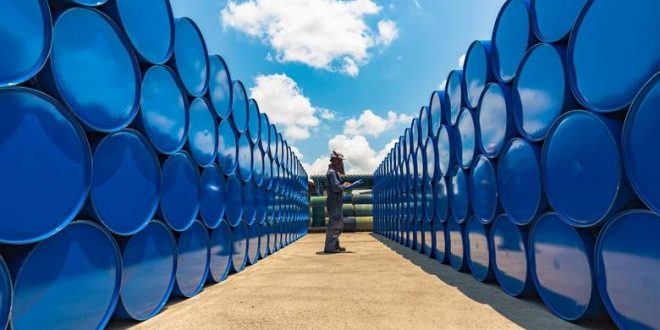Oil is expected to rise further this year amid supply constraints and higher demand as global economies continue to rebound from the coronavirus pandemic on the back of vaccination programmes and stimulus measures. And when the global economy regains its pre-pandemic momentum in a couple of years, crude could rise to $100 a barrel, according to analysts.
Brent, the international benchmark for more than half of the world’s crude, rallied to above $74 a barrel on Wednesday, while West Texas Intermediate, the key gauge for US oil, breached the $72 level. In early trading on Thursday Brent receded to $73.86 and WTI was trading at $71.66.
“With oil demand expected to rise strongly this summer and supply growth lagging demand growth, oil inventories will likely fall faster over the coming months,” Giovanni Staunovo, commodity analyst at UBS, said on Wednesday. “As such, we still see prices moving higher over the next three months.”
International efforts to widely distribute vaccines and a fall in infections mean policymakers are bullish about global growth. More than 2.42 billion doses of Covid-19 vaccines had been administered in 180 countries as of Wednesday, according to data collected by Bloomberg.
The Group of seven high-income countries (G7) also pledged to donate 1 billion Covid-19 doses over the next year to help poor countries inoculate their populations. Coronavirus infections are also declining in India, the world’s third-biggest consumer of oil.
Switzerland-based UBS raised its September price forecasts to $78 per barrel for Brent and $75 per barrel for WTI amid higher demand but expects a “modest setback toward the end of the year” as OPEC+ adds extra supply to the market.
Crude prices rallied after a group of top oil traders predicted high demand, which could prop up prices for the remainder of this year.
Executives from Vitol, Glencore and Trafigura and Goldman Sachs told the FT Global Commodities summit on Tuesday that $100 crude was a real possibility, with prices already reaching their highest level in two years this week.
“I actually think that there is a chance for oil to get up to those numbers,” Jeremy Weir, executive chair of Trafigura, told the summit.
“The issue for oil is not demand … the supply situation is quite concerning. We’ve gone from 15 years of reserves to 10 years. We’ve seen capital expenditure go from five years ago at $400 billion a year to just $100bn a year.”
Private oil majors such as Exxon, BP and Chevron are planning to curtail capital investment in order to manage emissions targets and prepare for an eventual slowdown in oil demand globally, Kuwait’s Kamco Invest said in a report earlier this week.
According to data from the International Energy Agency, spending by oil companies is expected to hit a six-year low during 2021, with the biggest decline coming from private oil majors, partially offset by higher spending mostly from national oil companies.
Alex Sanna, the top oil trader at Glencore, also said that $100 oil was looking more likely. “If you’re cutting supply without at the same time addressing your demand that is when you can get price dislocations,” Mr Sanna said. “You’re really only one or two events away from a material spike in oil prices.”
Oil prices are no longer related to demand outlook “but [are based] very much around the supply and what Saudis are doing and what Opec is doing on holding back supply”, Matt Stanley, senior broker at Dubai-based Starfuels, said.
“The longer they keep, the higher the prices will get and the markets are certainly looking like they wanted to go that way … and $80 is certainly on the cards.”
James Davis, director of short-term global oil service and head of upstream oil at London-based FGE, also expects oil to trade close to $80 per barrel on a daily basis in the coming months as demand continues to recover from the Covid-19 impact.
But crude prices could touch $100 after 2022 when the world returns to its pre-Covid demand growth trajectory but “supply and spare capacity are short, thanks to a deeper cutback in global upstream investment starting last year”, Vandana Hari, founder and chief executive of Singapore-based Vanda Insights, said.
However, she expects the current demand spike – prompted by a combination of summer holidays and the release of pent-up demand with the end of Covid curbs in the US and Europe – will be transitory.
“A clearer picture of more sustainable demand growth can be had only towards the end of Q3,” she said.

 Iran Energy News Oil, Gas, Petrochemical and Energy Field Specialized Channel
Iran Energy News Oil, Gas, Petrochemical and Energy Field Specialized Channel



